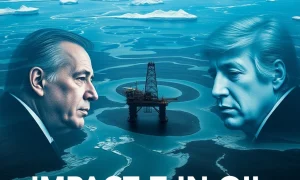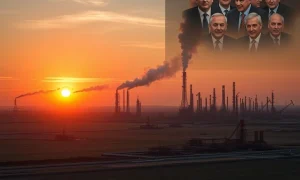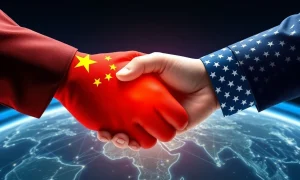For business leaders and entrepreneurs, understanding the intricate dynamics of the global energy market is paramount. Many observers once believed a single high-level summit, like the one between then-President Trump and Russian President Putin, could instantly resolve challenges related to global oil supplies. However, this perspective often overlooks the deep-seated complexities and diverse forces that truly govern the world’s crude output. The reality is far more nuanced than a simple political handshake.
Unpacking the Summit: Initial Hopes for Global Oil Supplies
The highly anticipated meeting between former US President Donald Trump and Russian President Vladimir Putin generated significant speculation. Many analysts and market participants held high hopes. They believed a direct dialogue between these powerful leaders might lead to a quick resolution for increasing global oil supplies. This optimism stemmed from the perception that both nations wield considerable influence over the international energy landscape. After all, the United States is a top producer, largely due to its burgeoning shale industry. Russia, similarly, remains a pivotal player within the OPEC+ alliance and on the world stage.
During that period, oil prices were a major concern for consumers and businesses alike. High crude costs could easily dampen economic growth. Consequently, any perceived opportunity to boost production quickly gained traction. Many wished for a swift diplomatic solution. However, the intricacies of the oil market rarely yield to such simple interventions. The forces at play are far too vast and interconnected. Furthermore, geopolitical considerations often override immediate economic desires. Thus, the summit’s potential impact on global oil supplies was always likely to be limited.
The Intricate Web: Complexities Governing Global Oil Supplies
The global oil market operates within an incredibly complex framework. It involves numerous stakeholders, diverse national interests, and unpredictable geopolitical events. Therefore, no single summit, regardless of the participants, can act as a “magic lever” to suddenly unleash vast new volumes of global oil supplies. Several key factors continually shape supply and demand dynamics:
- OPEC+ Decisions: This alliance of oil-producing nations, including Saudi Arabia and Russia, often dictates production quotas. Their collective actions significantly influence market availability.
- Non-OPEC Production: Countries outside OPEC+, particularly the United States with its shale boom, also contribute massively. Their output responds to market prices and technological advancements.
- Geopolitical Tensions: Sanctions, conflicts, and political instability in major producing regions can severely disrupt supply flows.
- Global Economic Health: Demand for oil is directly tied to economic activity. Recessions or booms directly impact consumption patterns.
These elements interact constantly. They create a dynamic and often volatile market. Therefore, expecting a quick fix from a bilateral meeting is unrealistic. Market forces and long-term investment cycles typically dictate true changes in supply.
Production Capacity and Geopolitical Constraints on Global Oil Supplies
Even if leaders desired an immediate increase in global oil supplies, practical limitations exist. Many oil-producing nations operate near their maximum sustainable capacity. Boosting output significantly often requires substantial long-term investment in new fields or enhanced recovery techniques. These projects take years, not weeks, to develop. Furthermore, geopolitical realities frequently impose significant constraints. For example, sanctions against countries like Iran and Venezuela severely restrict their ability to export oil. This removes a considerable volume from the global market. These sanctions are complex foreign policy tools. They are not easily lifted or altered based on a single meeting’s outcome.
Moreover, domestic political considerations within major oil-producing nations play a crucial role. Governments must balance revenue needs with environmental concerns, social stability, and long-term resource management. Russia, for instance, operates within its own strategic framework. Its production levels are often tied to its broader foreign policy objectives and internal economic stability, not solely to global price signals. Thus, increasing output beyond a certain point becomes a complex decision. It involves balancing many competing interests. These factors collectively limit the immediate flexibility of global oil supplies.
Understanding Demand Side Factors Influencing Global Oil Supplies
While much focus often rests on supply, the demand side equally influences global oil supplies and prices. Global economic growth remains a primary driver of oil consumption. As economies expand, energy needs rise, increasing demand for crude. Emerging markets, particularly in Asia, have historically driven much of this growth. Their industrialization and urbanization fuel a consistent need for transportation fuels and industrial feedstock. Therefore, a slowdown in global economic activity can quickly dampen demand, impacting prices and potentially leading to oversupply.
Conversely, robust economic performance can tighten markets. Furthermore, long-term trends like the energy transition also affect demand projections. The increasing adoption of electric vehicles and renewable energy sources, while still nascent in their overall impact, signals a future shift away from fossil fuels. This outlook influences investment decisions in new oil production. Companies may become hesitant to commit capital to projects with very long payback periods. Such hesitation can ultimately limit future global oil supplies. Therefore, understanding these demand-side dynamics is crucial for any accurate market assessment.
Why a ‘Magic Lever’ Does Not Exist for Global Oil Supplies
The idea of a single “magic lever” to control global oil supplies is fundamentally flawed. The market is far too vast and interconnected for any one leader or bilateral meeting to dictate prices or production levels unilaterally. Millions of decisions are made daily by producers, consumers, traders, and investors worldwide. These decisions collectively determine market direction. Furthermore, many stakeholders possess conflicting interests. For instance, high-cost producers benefit from elevated prices, while major consumers prefer lower costs. These divergent interests prevent easy consensus or quick policy shifts.
Oil is also a globally traded commodity. Its price reflects a delicate balance of supply and demand across various regions. Geopolitical events, natural disasters, and even financial market speculation can cause rapid price swings. No single government, however powerful, can completely insulate its economy from these global forces. Therefore, while high-level discussions can foster understanding or even lay groundwork for future cooperation, they rarely result in immediate, dramatic changes to the fundamental balance of global oil supplies. True shifts require broader market adjustments and sustained policy efforts.
Russia’s Pivotal Role and Its Impact on Global Oil Supplies
Russia holds a significant position within the global energy landscape. It is one of the world’s largest oil producers and exporters. Its influence extends through its participation in the OPEC+ alliance. This group coordinates production levels among major oil-producing nations. Russia’s decisions within OPEC+ can certainly sway market sentiment and affect global oil supplies. However, Russia also has its own complex economic needs and strategic objectives. These often dictate its production policy. For example, maintaining stable oil revenues is crucial for its state budget. This need often balances against its desire to cooperate with other producers to stabilize prices.
Moreover, Russia’s production capacity is not infinitely elastic. While it possesses vast reserves, increasing output rapidly can be challenging. It requires significant capital investment and adherence to technical constraints. Furthermore, Russia’s geopolitical stance and its relationship with other major powers also influence its energy policy. These factors mean Russia’s contribution to global oil supplies is a function of internal priorities and external relations. It is not simply a tap that can be turned on or off at will following a single diplomatic encounter.
US Policy and Its Effect on Global Oil Supplies
The United States has emerged as a dominant force in the global oil market. Its shale revolution fundamentally reshaped the supply landscape. This boom in domestic production has significantly boosted global oil supplies. It also reduced US reliance on foreign oil. However, the US government’s direct control over this output is limited. Most US oil production comes from private companies. These firms respond primarily to market prices and economic incentives, not direct government mandates. While the President can influence policy through regulations, tax incentives, or strategic petroleum reserve releases, they cannot simply order private companies to increase production.
Furthermore, US foreign policy tools, such as sanctions, directly impact the availability of oil from other nations. Sanctions against countries like Iran or Venezuela aim to exert political pressure. Yet, they also reduce the overall volume of global oil supplies available to the market. These are complex policy choices with broad implications. Therefore, while the US plays a critical role, its influence is often indirect. It operates through market forces and specific policy levers, rather than through direct control over private sector output or immediate diplomatic agreements with individual leaders.
The Long Road to Stabilizing Global Oil Supplies
Achieving stability in global oil supplies is a continuous and complex endeavor. It requires sustained effort and collaboration among numerous nations and stakeholders. No single summit, however high-profile, can offer a definitive, immediate solution. Instead, stability depends on a combination of factors:
- International Cooperation: Ongoing dialogue and coordination among major producing and consuming nations are vital. Forums like OPEC+ provide a platform for such discussions.
- Investment in Capacity: Long-term stability requires consistent investment in exploring new oil fields and developing existing ones. This ensures future supply meets projected demand.
- Managing Geopolitical Risks: Mitigating conflicts and political instability in key oil-producing regions is crucial. These events can severely disrupt supply chains.
- Technological Advancements: Innovations in extraction and refining technologies can enhance efficiency and increase recoverable reserves.
- Market Transparency: Providing clear data and forecasts helps reduce speculation and allows for more informed decision-making by market participants.
Ultimately, the market for global oil supplies is a dynamic system. It responds to a multitude of economic, political, and technological forces. Summits serve as important diplomatic channels. They allow leaders to discuss shared challenges and explore potential areas of cooperation. However, they are merely one piece of a much larger and more intricate puzzle. Real, lasting changes in global oil markets emerge from a confluence of sustained efforts, not from a single, decisive moment.
Conclusion: Beyond the Summit’s Immediate Horizon for Global Oil Supplies
The Trump-Putin summit, like many high-level diplomatic meetings, was a platform for dialogue. It allowed leaders to address pressing international issues. However, it was never a “magic lever” capable of instantly unleashing vast new global oil supplies. The complexities of the international oil market are simply too profound. They involve a delicate interplay of economic fundamentals, geopolitical realities, and the independent decisions of countless market participants. Understanding this intricate web is crucial for anyone seeking to comprehend the true drivers of energy prices and availability. Real solutions for market stability require ongoing collaboration, long-term investment, and an appreciation for the myriad forces at play. They do not come from single, isolated events.
Frequently Asked Questions (FAQs) About Global Oil Supplies
Q1: Why couldn’t the Trump-Putin summit immediately increase global oil supplies?
A1: The global oil market is incredibly complex. It involves numerous independent producers, geopolitical factors, and market forces. No single meeting, even between powerful leaders, can instantly change these dynamics. Production increases require long-term investment and are influenced by market prices and geopolitical stability, not just political will.
Q2: What are the main factors influencing global oil supplies?
A2: Key factors include OPEC+ production decisions, non-OPEC output (like US shale), geopolitical tensions (sanctions, conflicts), global economic demand, and long-term investment in new production capacity. These elements interact constantly to shape supply levels.
Q3: How does US shale production affect global oil supplies?
A3: The US shale revolution significantly boosted global oil supplies, making the United States a top producer. However, US production is largely controlled by private companies responding to market signals, not direct government orders. Its impact is therefore market-driven rather than politically mandated.
Q4: What role does Russia play in global oil supplies?
A4: Russia is a major oil producer and a key member of the OPEC+ alliance. Its production decisions within this group can influence market balances. However, Russia’s output is also guided by its own economic needs and strategic objectives, limiting its flexibility for sudden, large increases.
Q5: Can future diplomatic efforts stabilize global oil supplies?
A5: Diplomatic efforts can foster dialogue and cooperation, which are essential for long-term stability. However, they are just one component. Sustained stability requires ongoing international collaboration, consistent investment in production capacity, and effective management of geopolitical risks. No single event can provide a permanent fix.
























